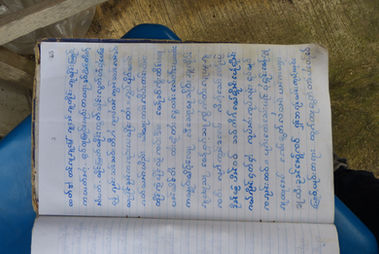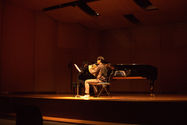
Signal Bell
Signal Bell, a senior recital by Ueaangkun Nurak (hornist) will perform solo and chamber music pieces using a concept to represent the idea of 'signal' and 'bell' to reconcile a sound (music) with human civilization from the ancient past through music composed by Mozart, Strauss, Persichetti, Bartók and Bozza. For the creative work in this recital, the performer had experience in a research field trip as a training ethnomusicologist to explore the bell’s sounds in Pang Ma Pha, Muang, Khun Yuam, and Mae Sariang districts at Mae Hong Son province which is a natural heritage area in Northern part of Thailand last November 2021, those bell's sounds inspired the performer to create a musical collage with the VDO. The performer hopes that the audience can approach those sounds and invite them to open their minds in the culture's imagination.



ฮอร์นเดิมทีทำมาจากเขาสัตว์ที่นำมาใช้ ส่งสัญญาณ สื่อสาร ล่าสัตว์ และเมื่อวิวัฒนาการจนกลายมาเป็นเครื่องดนตรีฮอร์น ฮอร์นยังทำหน้าที่สร้างสีสันให้กับวงดนตรีทั้งในรูปแบบเครื่องดนตรีเดี่ยว วงผสมดนตรีเชมเบอร์หรือแม้แต่วงดุริยางค์ซิมโฟนี โดยส่งสัญญาณเสียงผ่านลำโพงของฮอร์นในหลายมิติ ผู้แสดงเชื่อว่าเสียงฮอร์นเป็นสัญญานเสียงที่เมื่อได้ยินแล้วจะทำให้เติมเต็มความรู้สึกในมิติใดมิติหนึ่ง

Signal
“สัญญาณ” (signal) ราชบัณฑิตยสถานได้ให้ความหมายไว้ว่า “เครื่องหมายหรือเครื่องแสดงไว้ให้เห็นหรือให้ได้ยินเป็นต้นแม้อยู่ในระยะไกล เพื่อให้รู้ล่วงหน้าจะได้ระวังอันตรายหรือกระทําตามที่บอกหรือแนะไว้” “สัญญาณ” เป็นสิ่งที่อยู่กับ
วัฒนธรรมมุษย์มาโดยตลอดทุกยุคสมัย เช่น ทำสัญญาณเพื่อการสื่อสารโดยใช้เครื่องมือเพื่อให้เกิด ควันไฟ สร้างเสียง แสงไฟ S.O.S. เพื่อความรวดเร็วและเป็นสิ่งเตือน ซึ่งสัญญาณในแต่อย่างและแต่ละยุคสมัยได้ทำหน้าที่เหมือนเดิมแต่สารที่ส่งและผู้รับนั้นแตกต่างออกไป
Bell
“ลำโพง” (Bell) ไม่ได้แปลว่าระฆังได้อย่างเดียว ยังสามารถแปลความหมายได้ว่า ลำโพง กระดิ่ง กรวย การร้องโวยวาย หรือของที่กว้างออกจนมีรูปร่างคล้ายระฆังได้อีกด้วย พูดง่ายว่าคือสิ่งที่สร้างเสียงให้คนหันมาสนใจได้ ขนาดเล็กหรือใหญ่ เสียงสูงหรือต่ำก็ไม่สำคัญ และในทางดนตรีลำโพงยังเป็นชื่อส่วนหนึ่งของเครื่องดนตรีอีกด้วย พบมากในเครื่องดนตรีประเภทเป่า เป็นส่วนที่กว้างออกและเป็นส่วนสุดท้ายของการออกเสียงจากเครื่องดนตรี หน้าที่ของลำโพงในเครื่องดนตรีเป็นส่วนที่ไว้ขยายเสียงให้ดังและชัดมากขึ้นอีกด้วย

ดังนั้นสัญญาณจะมีความหมายชัดเจนมากขึ้นถ้ามีเครื่องมือที่ช่วยในการบอกสัญญาณ การตีระฆังวัดที่ไว้บอกสัญญาณต่างๆที่กำลังจะเกิดขึ้นหรือกำลังเกิดขึ้นอยู่ เช่น การตีบอกว่าพรุ่งนี้วันพระ พรุ่งนี้มีงานบวช การบอกเวลา งานแต่งงาน รวมถึงการส่งสัญญานเตือนภัยอีกด้วย นอกจากนี้ Bell ยังปรากฏอยุ่ในสำนวนของภาษาอังกฤษ คือ saved by the bell ที่ใช้ในเหตุการณ์ที่รอดหวุดหวิดจากสัญญาณบางอย่าง โดยการแสดงครั้งนี้จะใช้ French Horn เป็น “Bell” ที่พูดถึงและมี ”Signal” คือเพลงที่ใช้ในการแสดงให้พูดถึงหน้าที่ของ Bell ในแต่ละยุคผ่านบทเพลงต่างๆในยุคสมัยที่ต่างกันว่าสื่อสารและเปลี่ยนแปลงไปอย่างไรบ้างต่อผู้รับสาร
Repertoire
Wolfgang Amadeus Mozart Horn Concerto No. 3 E flat major K. 447
Vincent Persichetti Parable for Horn, Op. 120
Eugene Bozza - Sur les Cimes for Horn and Piano
Suppabhorn Suwanpakdee Resonance "Mae Sariang" for Horn solo and String Quartet
Richard Strauss Alphorn for Clarinet, Horn and Piano, TrV64 No. 3
Bela Bartok Romanian Folk Dances for Flute, Horn and Piano
Ueaangkun Nurak Bell (musical collage and VIDEO/Graphic score for senior recital)

Wolfgang Amadeus Mozart (1756 – 1791) was a prolific and influential composer of the Classical period.Concerto No. 3 in E-flat Major, K. 447, was originally written for natural horn and the performer Joseph Leutgeb (1732-1811). This work was completed between 1784 and 1787. The difficulty in this piece lies in the nuance of performing in the classical style. Additional technical difficulties include lip trills and some fast sixteenth-note runs.
This work is in 3 movements
Allegro: Time signature 4/4 in E-flat Major
Romance (Larghetto) Time signature C cut in A-Flat major
Allegro: Time signature 6/8 in E-flat Major
Wolfgang Amadeus Mozart Horn Concerto No. 3 E flat major K. 447
Sur les Cimes in French means on the Peaks of mountain. Bozza utilized many extended techniques possible as performance practices on horn in the mid-20th century. Sur les Cimes for horn and piano is an homage by Bozza, to the horn’s history as a hunting instrument. This piece is challenging because of its large range, dotted rhythms, fast
chromatic passages, use of stopped horn, muted horn, double tonguing, and lip trills. Like Bozza’s other works the piece consists of five segments that are through composed; moreover, there is a cadenza-like section that requires a lot of bravado from the performer to herald the heroic hunting motives.
Eugene Bozza Sur les Cimes for Horn and Piano
Vincent Persichetti Parable (VIII )for Horn, Op. 120
This particular piece is the eighth in a series of twenty Parables for solo instruments – flute, piccolo, oboe, English horn, clarinet, bassoon, alto sax, horn, trumpet, trombone, tuba, viola, cello, double bass, harp, organ, carillon, guitar, harpsichord, and piano. Persichetti mentions, “ My Parables are one-movement musical essays about a single germinal idea. This unaccompanied work is quite demanding. Its technical difficulties include mixed
meters, difficult intervals, and large leaps. Lyrically, its phrases demand maturity from the
performer. Even though it is a difficult work it is not inaccessible to the undergraduate student.
This piece is one that challenges the performer and the audience; nevertheless, it is a standard
selection in the repertoire.
Richard Strauss Alphorn for Clarinet, Horn and Piano, TrV64 No. 3
This piece from ‘seinem lieben Papa’ poet and "Ein Alphorn hör’ ich schallen" his work. We hear the alpine horn serenely reverberating over mountain and valley, with its simple call consisting of the broken chord of one major triad. The rather Schubertian spell is disturbed only by restless minor key music at verse 3, but the last lines restore the gentle mood. The idyllic freshness of the opening bars of this youthful effusion was something Richard Strauss never lost the ability to conjure up. For all his progressive harmonic daring, he was ever able to evoke the simplest bucolic nature-mood, for example in such late works as Daphne, the Oboe Concerto or the Clarinet and Bassoon Concertino. Originally this piece have Soprano, Horn and Piano but in my recital I arranged soprano line to clarinet because I want sound of the nature.
Béla Bartók: Romanian Folk Dances (1915), arr. by Natthapat Kirawiroj
Béla Bartók one of the most famous composers of the 20th century. He is perhaps most famous for expertly combining folk material with classical music. Romanian Folk Dances is a suite of six short piano pieces based on Romanian tune from Transylvania. Unfortunate, I never saw this piece arranged for horn, flute and piano before. Probably because it’s hard to orchestrate in this combination. I decided to make an arrangement for this combination to play with my close friend, Wasin Kosonrat, Flutist. This is our first time playing together and we can’t wait to present these beautiful folk dances for you.
Suppabhorn Suwanpakdee Resonance "Mae Sariang" for Horn solo and String Quartet
แรงบันดาลใจจากความงดงามของแม่น้ำสาละวิน และประวัติศาสตร์ที่เล่าเรื่องราวของคนแม่สะเรียงผ่านการเคลื่อนย้าย แลกเปลี่ยน ซื้อขายของคน และบทเพลงแม่สะเรียงที่ถูกขับขานด้วยวงดนตรีพื้นบ้านน้ำดิบ ทำให้บทประพันธ์ชิ้นนี้เป็นบทประพันธ์ชิ้นเดียวที่เครื่องดนตรีฮอร์น บรรเลงเดี่ยวร่วมกับวงเครื่องสายสี่ชิ้นบทประพันธ์นี้ประกอบด้วย
-
ท่อนที่ 1 ได้แก่ตอนที่หนึ่งแม่น้ำสาละวิน เสียงฮอร์นเปรียบดังแม่น้ำที่หล่อเลี้ยงผู้คนในลุ่มแม่น้ำสาละวิน แนวทำนองสลับร้องล้อกันระหว่างเครื่องดนตรีฮอร์นเดี่ยวร่วมกับวงเครื่องสายสี่ชิ้น เสียงดนตรีทำให้เห็นถึงมิตรภาพระหว่างผู้ขนสองฟากแม่น้ำ โดยเสียงได้รับแรงบันดาลใจจากเสียงบทสวดอานิสงส์กฐินของพระอัษดิน เจ้าโอ๊ตเจ้าอาวาสวัดศรีบุญเรือง ซึ่งในช่วงปลายของแต่ละวรรคมีความงดงามมีหลายรูปแบบซึ่งเป็นลักษณะเฉพาะตัวคล้ายระดับเสียงที่เกิดจากอนุกรมเสียงทางดนตรี (Harmonic series) )หรือลำดับความถี่และเสียงบริสุทธิ์
-
ท่อนที่ 2 แม่สะเรียงบทเพลงพื้นบ้านที่ทุกคนคุ้นหูบทเพลงนี้ได้รับแรงบันดาลใจที่นำเสนอช่วงทำนองเดิมและกลิ่นอายวิถีชีวิตที่สะท้อนถึงชีวิตความรักความห่วงใยวัฒนธรรมล้านนาผู้คนในแม่สะเรียง
บทเพลงได้ทำการแสดงครั้งแรกที่แม่ฮ่องสอนที่มีชื่อว่า ลำนำเพลงอันชื่นใจ ความทรงจำที่สดใส และถิ่นแดนไกลในม่านหมอก: โครงการวิจัยการยกระดับมรดกวัฒนธรรมเพื่อการท่องเที่ยวเชิงสร้างสรรค์ในจังหวัดแม่ฮ่องสอน Uplifting Tunes, Vivid Reminiscence, and Misty Town: Upgrading Cultural Heritage for Creative Tourism in Mae Hong Son Province
ข้อมูลเพิ่มเติม



Ueaangkun Nurak: Bell
(musical collage and VIDEO/Graphic score for
senior recital)
เป็นผลงานสร้างสรรค์ที่ทำขึ้นมาจากจากสิ่งที่ได้เก็บมาจากการไปทำวิจัยภาคสนามที่แม่ฮ่องสอนซึ่งนำเสียงการสัมภาษณ์ เสียงเครื่องดนตรี soundscape ต่างๆ ภาพและวิดีโอที่บันทึกไว้และเพลงชาติพันธุ์ต่างๆในแม่ฮ่องสอนที่เก็บมานำมาทำเป็นผลงานชิ้นนี้





















































